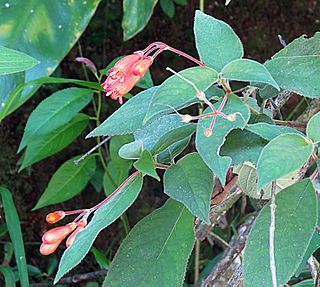
Joseph Marie Henry Alfred Perrier de la Bâthie was a French botanist who specialized in the plants of Madagascar.
Matudaea is a genus of plant in family Hamamelidaceae.
Conrad Vernon Morton was an American botanist, who did notable writings on Ferns. He was also a specialist in Gesneriaceae and Solanaceae for the Smithsonian Institution from 1928.
Nelsonianthus is a genus of flowering plants belonging to the family Asteraceae.
Mortoniella is a monotypic genus of flowering plants in the family Apocynaceae, first described as a genus in 1939. It contains only one known species, Mortoniella pittieri, native to Central America.
Steyermarkia is a monotypic genus of flowering plants belonging to the family Rubiaceae. It only contains one known species, Steyermarkia guatemalensisStandl.
Neogoezia is a genus of flowering plants belonging to the family Apiaceae.
Kearnemalvastrum is a genus of flowering plants belonging to the family Malvaceae.
Mirandea is a genus of flowering plants belonging to the family Acanthaceae.
Mortoniodendron is a genus of flowering plants belonging to the family Malvaceae.
Neobrittonia is a monotypic genus of flowering plants belonging to the family Malvaceae. It only contains one known species, Neobrittonia acerifolia
Neomortonia is a monotypic genus of flowering plants belonging to the family Gesneriaceae. It just contains one species, Neomortonia roseaWiehler
Pisoniella is a monotypic genus of flowering plants belonging to the family Nyctaginaceae. It only contains one known species, Pisoniella arborescens(Lag. & Rodr.) Standl.
Schultesianthus is a genus of flowering plants belonging to the family Solanaceae.
Killipia is a genus of flowering plants belonging to the family Melastomataceae. It is now a synonym of MiconiaRuiz & Pav..
Megacorax is a monotypic genus of flowering plants belonging to the family Onagraceae. The only species is Megacorax gracielanusS.González & W.L.Wagner.
Nectouxia is a monotypic genus of flowering plants belonging to the family Solanaceae. The only species is Nectouxia formosa. It is in the Solanoideae subfamily and in Subtribe Salpichroinae, which is a subtribe of Physaleae.
Ochoterenaea is a monotypic genus of flowering plants belonging to the family Anacardiaceae. The only species is Ochoterenaea colombiana.

Presliophytum is a genus of flowering plants belonging to the family Loasaceae.

Moussonia is a genus of plants in the family Gesneriaceae. Its native range stretches from Mexico to Central America. It is found in Costa Rica, El Salvador, Guatemala, Honduras, Mexico and Panamá.



